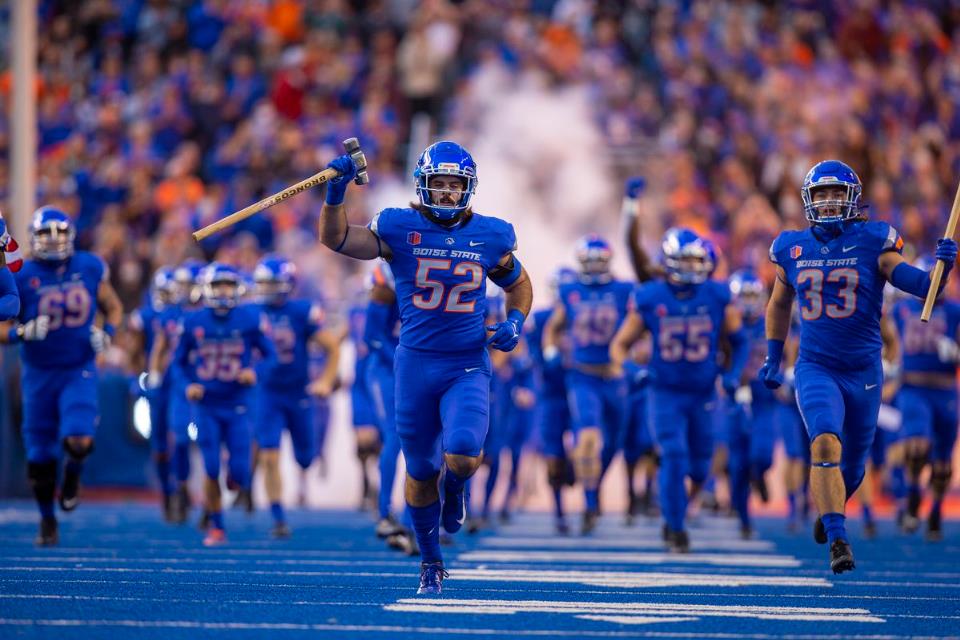
COMMENTARY: How big did Boise State win in Pac-12 move? That remains to be seen…
The next round of conference realignment kicked off Thursday morning with Boise State being one of the early winners. The Broncos, along with Colorado State, San Diego State and Fresno State, accepted an invitation to join the Pac-12 beginning July 1, 2026.

It’s a move Bronco fans have been dreaming of for decades. Ever since Ian Johnson ran in the two-point conversion try on the famous Statue of Liberty play to beat Oklahoma in the Fiesta Bowl on Jan. 1, 2007, Bronco Nation has longed for opportunities to show it belongs on the big stage. It’s a dream that led Boise State to joining the Mountain West in 2011 and 15 years after that will lead the Broncos to joining the Pac-12.
It’s a move that gives Boise State two new regional rivals. Corvallis, Oregon and Pullman, Washington are both within driving distance of Boise, so fans will easily be able to make trips to see the Broncos take on the Beavers and Cougars.
But just how big did Boise State win on Thursday? Have the Broncos finally made it to the big stage? That remains to be seen.
Let’s be clear on one thing, this is not the Pac-12 of 2007, or even the Pac-12 of 2022. When USC and UCLA announced their 2024 move to the Big Ten in July 2022 it set off a shockwave that devastated the Pac-12 as we knew it one year later. In 2023 Oregon and Washington joined the two Los Angeles schools in the Big Ten. Colorado, Arizona, Arizona State and Utah bolted for the Big 12. Cal and Stanford leapt off the sinking ship for greener pastures in the ACC.
That left Washington State and Oregon State stranded, forced to rebuild from the ruins. The schools took the first step Thursday, adding the four Mountain West schools. But more will need to be done. In order to maintain eligibility status to remain in the FBS, the league will need at least eight teams by 2026. With Thursday’s additions, the conference stands at six members. Who those still unknown two-plus future members will be could dictate how much of a win this turns out to be for Boise State.
There are a few different directions the Pac-12 could possibly go. The simplest answer would be more raiding of the Mountain West. But it begs the question, if the league plans to eventually add more Mountain West schools, why not do it in round one?
That answer, along with just about everything else in conference realignment, might come down to money. The Mountain West will already be owed $111 million in exit fees and fees from the Mountain West per their ‘7+1’ scheduling agreement for the 2024 season. The Pac-12 can easily cover that, having received a reported $250 million in its settlement with the 10 schools that departed.
More schools would cost more, so perhaps the league is still trying to negotiate.
But would an abridged Mountain West plus Oregon State and Washington State be better than staying put? It’s very possible. Keep in mind Oregon State and Washington State were able to keep the Pac-12’s brand, as well as the money from NCAA Tournament units and existing media rights contracts that come with it, so right away that’s a gain on staying in the Mountain West.
Also think back to when Boise State left the WAC for the Mountain West in 2011. Within a couple of years five of the remaining eight WAC schools also joined the Mountain West. Despite that, the move to the Mountain West still proved to be a boon to Boise State.

Of the WAC schools that remained, Louisiana Tech and New Mexico State are currently in Conference USA and Idaho eventually dropped down to the FCS level.
Other ideas that have floated around social media on Thursday include Cal and Stanford returning to the Pac-12. But with those two schools having signed grant of rights with ACC through 2036, it’s hard to see them wanting to jump through the legal hoops to escape after one or two years.
It would be more likely to see a couple of other Group of Five powerhouses decide to make the jump to the Mountain West. If conference realignment has taught us anything, it’s that geography doesn’t matter, so maybe a few schools farther east would be tempted to make the jump. A school like Memphis would raise both the football and men’s basketball profile of the conference. While other AAC schools like UTSA (University of Texas-San Antonio) or Tulane might not do the same for basketball, they certainly would for football.

There is still a lot that will need to be ironed out in the coming weeks or months. But given the track record of Boise State’s leadership team, you have to believe President Dr. Marlene Tromp and Athletic Director Jeramiah Dickey would not have taken on this venture without some sort of plan that would put Boise State’s athletic teams in the best position to be successful.
“The more I talked to those athletic directors, the more it was apparent they are not settling, they are going to invest and they are going to continue to be bar raisers at their own institution,” Dickey said at his Thursday press conference announcing BSU’s move to the Pac-12. “I’m very grateful for them and we need to find people that are going to abide by that.”

Leave a Reply